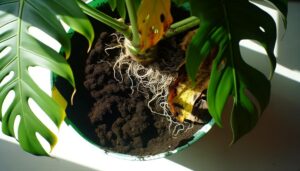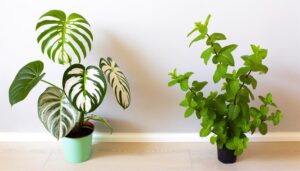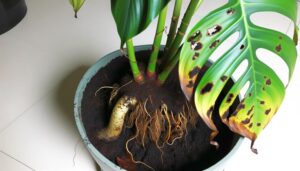What Does It Mean When Monstera Leaves Turn Yellow With Brown Spots?
Yellowing Monstera leaves with brown spots usually point to issues such as improper watering, pest infestations, or fungal infections. Overwatering can cause root rot and anaerobic soil conditions, while underwatering leads to root desiccation and nutrient transport disruption.
Pests like spider mites or scale insects damage cellular structures, causing chlorosis and necrosis. Poor drainage diminishes chlorophyll production, and nutrient imbalances result in similar symptoms.
Additionally, inadequate light and temperature stress can exacerbate these problems. Monitoring these factors closely will help you keep your Monstera healthy and thriving.
By doing so, you’ll uncover further insights into maintaining the best plant health.

Key Takeaways
- Overwatering can cause yellow leaves with brown spots due to root rot and impaired nutrient uptake.
- Pests like spider mites and thrips can lead to yellow leaves with brown spots by feeding on plant sap.
- Inadequate drainage leads to waterlogged soil, resulting in oxygen deprivation and root rot.
- Nutrient deficiencies, especially imbalanced soil pH or inadequate fertilization, can cause chlorosis and necrotic spots.
- Temperature fluctuations outside the optimal range of 65°F to 85°F can stress the plant, causing yellowing leaves with brown spots.
Overwatering Issues
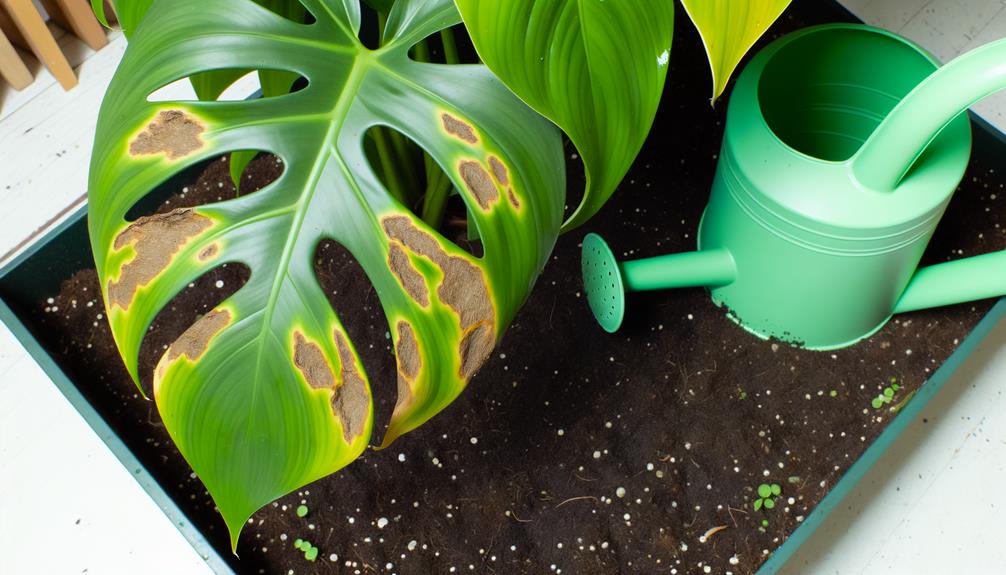
When your Monstera leaves start turning yellow with brown spots, overwatering is often the primary culprit, leading to root rot and impaired nutrient uptake.
Excessive water saturates the soil, creating anaerobic conditions that harm roots. Without sufficient oxygen, the roots can’t effectively transport nutrients, causing chlorosis, or yellowing of the leaves.
Brown spots indicate localized cell death due to fungal pathogens thriving in overly moist environments. To remedy this, verify your Monstera’s pot has proper drainage and allow the top inch of soil to dry out before watering again.
You might also consider using a soil moisture meter for precision. By adjusting your watering habits, you can restore your Monstera’s health and prevent further leaf discoloration.
Underwatering Effects
When your Monstera lacks sufficient moisture, it can lead to desiccated, yellowing leaves with brown spots, a clear sign of cellular dehydration.
This inadequate water supply also impairs root health, causing them to become brittle and less effective at nutrient uptake.
Consequently, the plant’s overall vigor diminishes, compromising its growth and resilience.
Lack of Moisture
Insufficient watering often causes Monstera leaves to turn yellow with brown spots due to cellular dehydration and nutrient transport disruption. When the soil lacks adequate moisture, the plant’s cells can’t maintain turgor pressure, leading to wilting and chlorosis (yellowing).
Dehydration hampers the plant’s vascular system, restricting the flow of essential nutrients like potassium and magnesium. This deficiency manifests as interveinal chlorosis and necrotic spots. Additionally, a dry substrate reduces transpiration, further limiting nutrient uptake.
You should monitor soil moisture levels consistently and water your Monstera when the top inch of soil feels dry. Using a well-draining mix prevents water stagnation while ensuring sufficient hydration. Proper moisture management is vital for maintaining healthy, vibrant foliage and preventing the stress symptoms associated with underwatering.
Root Health Impact
Proper watering not only affects the foliage but also plays a pivotal role in maintaining root health, as inadequate hydration can lead to root desiccation and impaired nutrient uptake. When Monstera roots lack sufficient moisture, they can’t efficiently absorb essential minerals and water, leading to stress and subsequent leaf discoloration.
Yellowing leaves with brown spots often signify that the roots are struggling to function at their best due to dehydration. This condition hampers the plant’s ability to photosynthesize effectively, as chlorophyll production diminishes.
To mitigate these effects, optimize consistent soil moisture without waterlogging. Employ a well-draining substrate and monitor the plant’s hydration needs regularly, adjusting your watering schedule based on environmental conditions and the plant’s growth stage.
Poor Drainage Problems
Poor drainage can lead to waterlogged soil, which deprives Monstera roots of oxygen and promotes the development of root rot. When roots can’t access sufficient oxygen, they begin to deteriorate, causing nutrient uptake to plummet. This lack of essential nutrients manifests in yellowing leaves with brown spots.
Waterlogged conditions also create a favorable environment for pathogenic fungi, further exacerbating root damage. To mitigate poor drainage, guarantee your pot has adequate drainage holes and use a well-aerated soil mix. Incorporate materials like perlite or orchid bark to improve soil structure.
Pest Infestations
Pest infestations can cause Monstera leaves to yellow and develop brown spots.
You should be aware of common pests like spider mites, scale insects, and thrips, which feed on the plant’s sap, causing cellular damage.
Identifying pest damage involves looking for signs such as webbing, honeydew excretion, and tiny, moving specks on the undersides of leaves.
Common Pests Affecting Monstera
Insect infestations, including spider mites, scale insects, and thrips, can severely compromise the health of your Monstera by causing yellowing leaves with brown spots. These pests feed on the plant’s sap, leading to cellular damage and nutrient deficiency.
Spider mites, often found on the undersides of leaves, create fine webbing. Scale insects attach themselves to stems and foliage, forming protective shells. Thrips are tiny, slender insects that leave silvery streaks and black specks.
| Pest | Description |
|---|---|
| Spider Mites | Tiny, create webbing, cause stippling |
| Scale Insects | Hard shells, suck sap, cause yellowing |
| Thrips | Slender, cause streaks and specks |
| Mealybugs | Cotton-like masses, feed on sap |
Each pest has distinct characteristics, but all result in the same detrimental symptoms for your Monstera.
Identifying Pest Damage
Recognizing the signs of pest damage on your Monstera involves closely inspecting the leaves, stems, and undersides for specific symptoms like webbing, hard shells, silvery streaks, and cotton-like masses.
Spider mites often create fine webbing and leave tiny yellow or white spots on the foliage. Scale insects appear as hard, oval shells adhering to stems and leaves, often accompanied by a sticky residue known as honeydew.
Thrips are slender insects that leave silvery streaks and black fecal spots. Mealybugs are identifiable by their white, cotton-like masses on the plant. Each of these pests can cause chlorosis (yellowing of leaves) and necrosis (brown spots), compromising your Monstera’s health.
Early detection and treatment are essential for mitigating damage and ensuring robust growth.
Fungal Infections
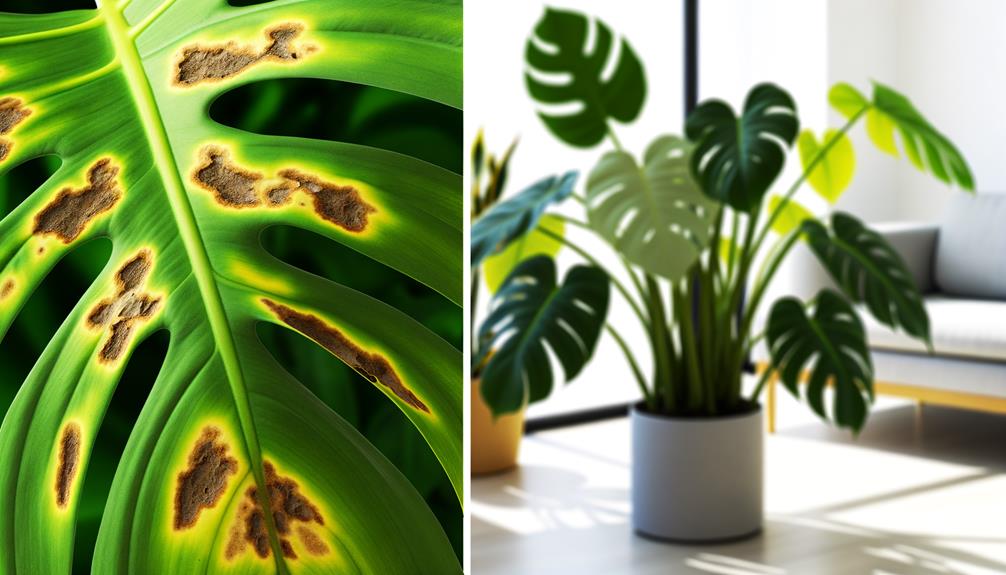
Fungal infections in Monstera plants often manifest as yellowing leaves with brown spots, caused by pathogens like Phytophthora and Fusarium. These fungi thrive in overly moist conditions, attacking the plant’s vascular system and leading to chlorosis (yellowing) and necrosis (browning).
You’ll notice that affected areas are often water-soaked and may have a slimy texture. To combat these infections, ensure proper drainage, reduce humidity, and avoid overhead watering. Applying a fungicide specifically labeled for Phytophthora and Fusarium can help eliminate the pathogens.
Regularly inspect your Monstera for early signs of infection and remove any affected leaves. Maintaining a clean growing environment minimizes fungal spore proliferation, keeping your plant healthy and vibrant.
Nutrient Deficiencies
When Monstera leaves turn yellow with brown spots, nutrient deficiencies could be a primary culprit, often resulting from imbalanced soil pH or inadequate fertilization.
Nutrient imbalances disrupt essential physiological processes. For example, nitrogen deficiency causes chlorosis, leading to yellowing leaves. Potassium deficiency manifests as brown, necrotic spots, compromising cellular integrity.
Magnesium is essential for chlorophyll production; its lack may result in interveinal chlorosis, where the leaf veins remain green while the tissue between turns yellow. Iron deficiency, often indicated by young leaves turning yellow, also stems from improper pH levels.
Regularly test your soil’s pH and amend it accordingly, ensuring nutrient uptake. Employ a balanced, slow-release fertilizer to correct and prevent deficiencies, aiding your Monstera’s best growth.
Sunlight Requirements
Maintaining your Monstera receives the best amount of sunlight is crucial for preventing yellow leaves with brown spots. Monstera deliciosa thrives in bright, indirect light. Direct sunlight can cause photodamage, leading to chlorosis (yellowing) and necrosis (brown spots).
Place your plant near an east or north-facing window to optimize light exposure while avoiding intense midday rays. If natural light is insufficient, consider using full-spectrum grow lights to mimic sunlight. Light levels directly influence photosynthetic efficiency and overall plant health.
Monitor leaf color and growth patterns to adjust light conditions accordingly. Remember, consistent light exposure without extremes guarantees your Monstera maintains its vibrant, healthy foliage, free from discoloration and damage.
Temperature Stress
Just as light levels affect your Monstera’s health, temperature fluctuations can also lead to yellowing leaves with brown spots, signaling stress.
Monstera plants thrive in consistent temperatures, ideally between 65°F and 85°F. Sudden drops or rises can disrupt cellular functions, causing chlorosis (yellowing) and necrosis (brown spots).
| Temperature Range (°F) | Effect on Monstera | Symptoms |
|---|---|---|
| 65 – 85 | Best growth | Healthy, vibrant leaves |
| 50 – 64 | Cold stress | Yellowing leaves, slower growth |
| <50 | Severe cold stress | Brown spots, potential wilting |
| 86 – 95 | Heat stress | Yellowing leaves, crisp edges |
| >95 | Severe heat stress | Brown spots, leaf drop |
Maintain stable temperatures to avoid stress responses. Use a thermometer to monitor and optimize your Monstera stays within its ideal range.
Conclusion
To sum up, your Monstera’s yellowing leaves with brown spots indicate distress. Whether it’s excessive watering, insufficient watering, inadequate drainage, pests, fungi, nutrient deficiencies, sunlight mismanagement, or temperature stress, each factor plays a significant role.
Delve into the specifics, identify the issue, and take corrective measures. Remember, a healthy Monstera reflects your plant care skills. So, don’t lose hope—empower yourself with knowledge and turn your Monstera into a flourishing, verdant masterpiece.


